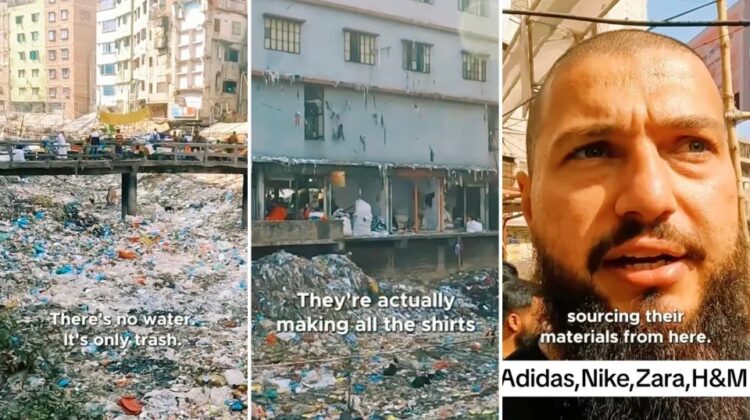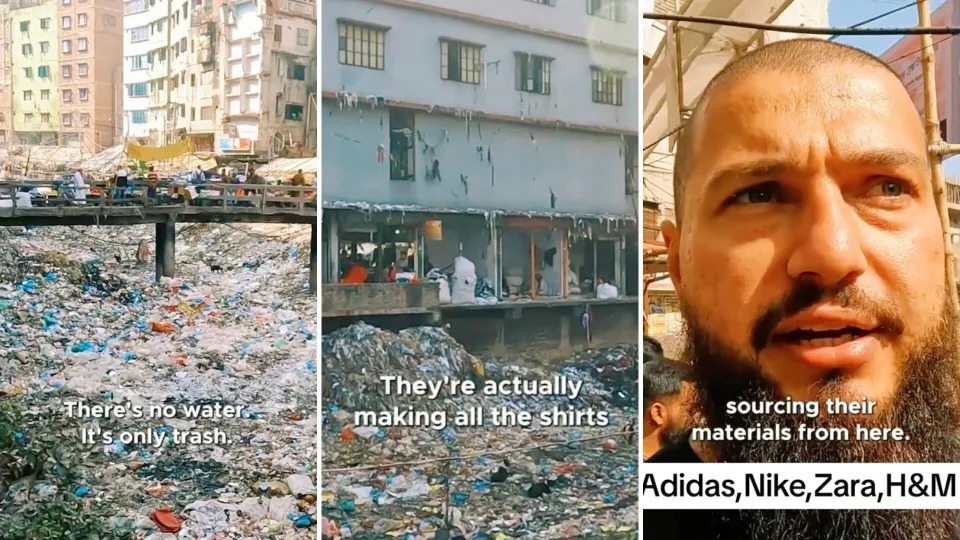
In a sobering revelation of environmental degradation, a video depicting the harrowing reality of textile pollution in Bangladesh has sparked outrage and concern among viewers worldwide.
The footage, shared on TikTok by user Fantastic Planet (@fantasticplanet007), showcases a desolate riverbed in an unnamed city, inundated with discarded textiles and multicolored plastics. With haunting clarity, the narrator declares, “That’s a trash river. There’s no water; it’s only trash. This is insane.”
As the camera pans across the debris-strewn landscape, the unmistakable logos of renowned clothing brands—Adidas, Zara, H&M, Nike—are flashed, prompting a sobering realization among viewers that the very garments adorning them may have originated from this environmental catastrophe.
The video serves as a stark reminder of the hidden costs of fast fashion, laying bare the destructive footprint of billion-dollar clothing companies operating with impunity. Despite the convenience and affordability offered by fast fashion, the toll on the environment and human well-being is immeasurable.

The statistics underscore the magnitude of the issue: 73% of imported clothes in the United States in 2023 hailed from Asia, with Bangladesh emerging as a key player in the global garment industry. With $44 billion in garment exports in 2021 alone, Bangladesh’s textile sector epitomizes the nexus of economic prosperity and environmental degradation.
Yet, the repercussions extend far beyond the confines of Bangladesh. The energy-intensive production processes, coupled with the rampant shedding of microfibers and the discharge of harmful chemicals into waterways, pose grave threats to ecosystems and public health worldwide.
Moreover, the insidious impact of textile pollution transcends mere visual blight, contributing to heightened risks of severe flooding and exacerbating carbon emissions. Alarmingly, the apparel industry surpasses both aviation and shipping in terms of carbon output, perpetuating a cycle of environmental degradation with global ramifications.
Despite regulatory measures ostensibly aimed at mitigating pollution, their efficacy remains dubious. Reports indicate that treatment plants in Bangladesh only remove 68% of microplastics on average, exacerbating environmental contamination and endangering vulnerable communities.
Efforts to combat the scourge of fast fashion are underway, with a burgeoning movement towards sustainable and eco-friendly alternatives gaining traction. The rise of eco-conscious clothing brands and the promotion of circular economy principles offer glimmers of hope in an otherwise bleak landscape.
Furthermore, consumer activism plays a pivotal role in effecting change, with conscientious purchasing decisions and the embrace of secondhand clothing serving as potent tools for divestment from the fast-fashion paradigm.
Yet, the urgency of the situation demands collective action on a global scale. As the video from Bangladesh underscores, the consequences of unchecked consumerism reverberate far beyond national borders, implicating all stakeholders in the imperative quest for sustainable solutions.
In the face of looming environmental catastrophe, the time for complacency is over. It is incumbent upon individuals, corporations, and governments alike to confront the perils of fast fashion head-on and chart a course towards a more equitable, sustainable future. Only through concerted effort and unwavering commitment can we hope to avert the looming environmental crisis and safeguard the planet for future generations.

Leave a Reply